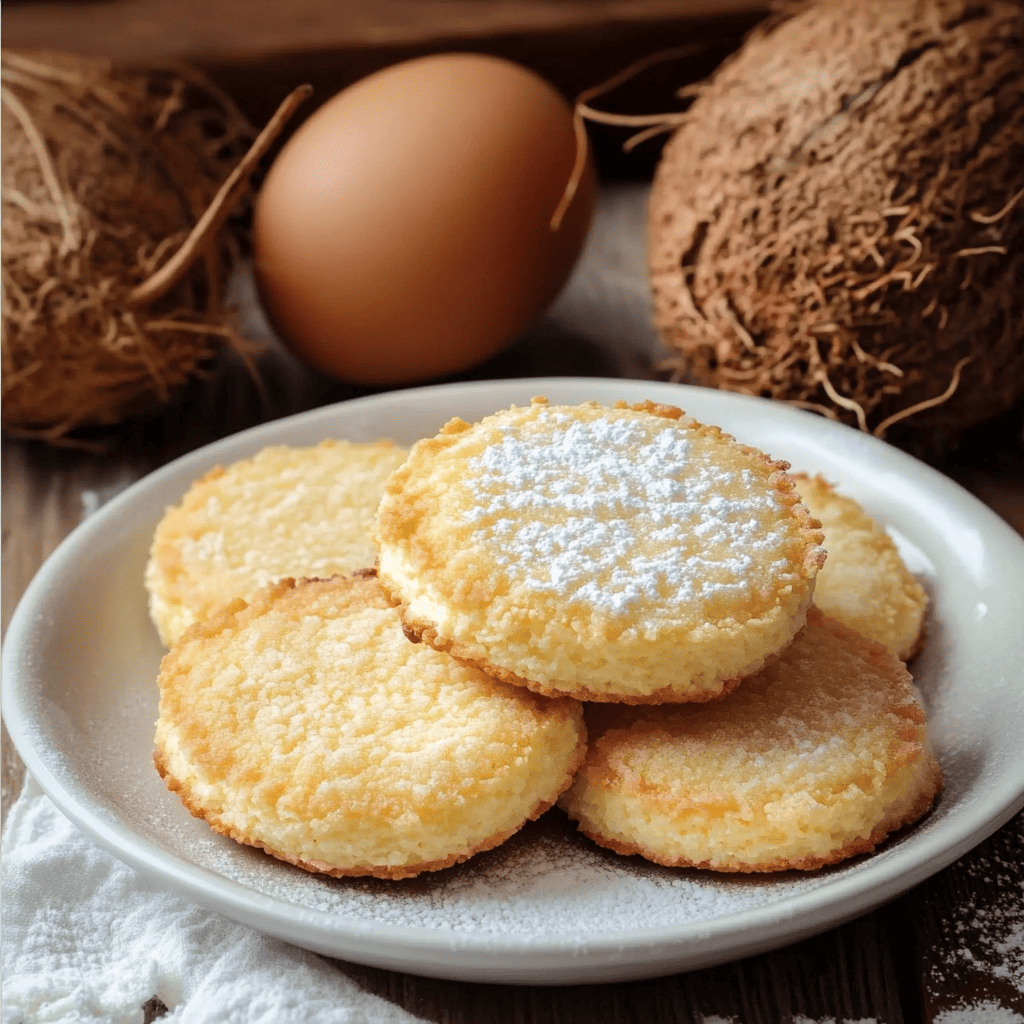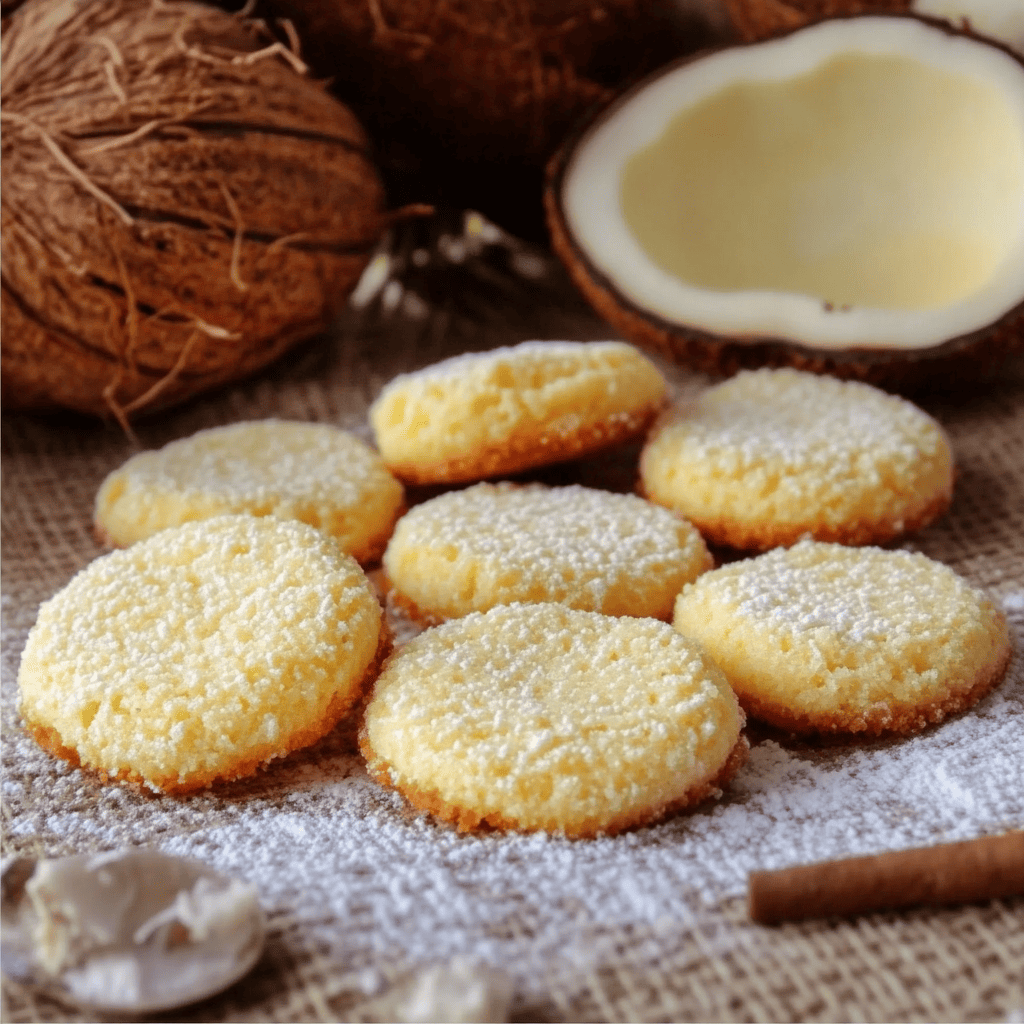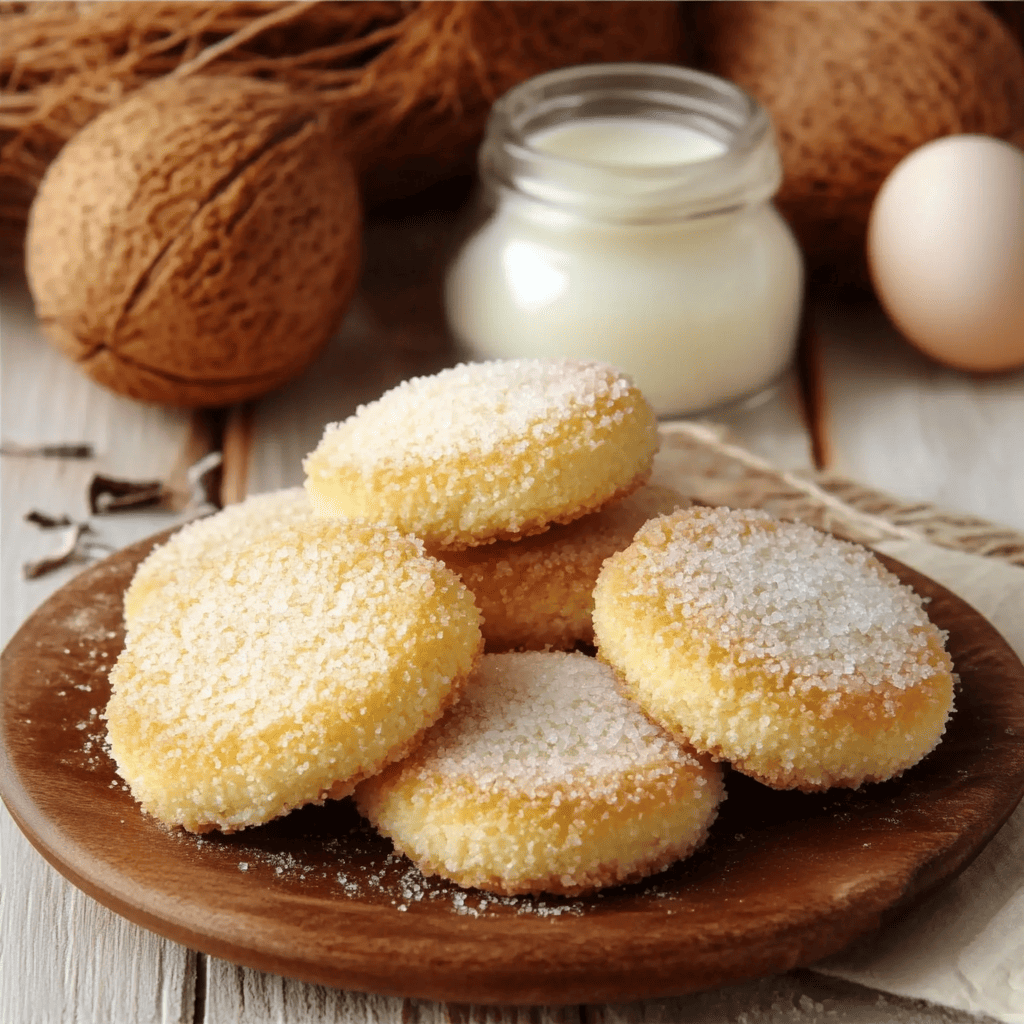Coconut Cookies
Introduction
Coconut cookies are a delicious dessert that combines the softness and sweetness of shredded coconut with the crispy, golden texture of a well-baked cookie. Their easy preparation and exquisite flavor make them an ideal choice to accompany coffee, tea, or simply enjoy at any time of day. Thanks to their balance of sweetness and aroma, these cookies have gained popularity in various culinary cultures around the world.
Coconut cookies are a delicious pastry that combines the tropical flavor of coconut with the crispy, golden texture of a well-baked cookie. Their simple and versatile recipe makes them an ideal choice for both cooking beginners and baking experts.
This dessert has been part of diverse culinary cultures throughout history, adapting to different ingredients and preparation styles depending on the region. From Latin America to Asia, coconut has been used as a fundamental ingredient in sweets and desserts due to its sweet and exotic flavor, ease of preservation, and high nutritional value.
Coconut cookies are not only delicious, but they’re also a healthier alternative to other desserts, as coconut contains fiber, healthy fats, and antioxidants. Their unique texture, which combines a slightly crunchy coating with a soft and fluffy interior, makes them irresistible for any occasion.
In this in-depth look, we’ll explore the history of these cookies, their importance in gastronomy, their ingredients and preparation process, as well as some popular variations on the recipe. We’ll discover why these cookies have won over so many people’s palates and how you can make them at home to enjoy their authentic, homemade flavor.
History and origin
Coconut has been a key ingredient in baking in many tropical regions for centuries. Its use in cooking dates back to ancient civilizations in Southeast Asia and Latin America, where coconut was incorporated into traditional desserts due to its exotic flavor and ease of preservation.
Coconut cookies, as we know them today, emerged from the combination of European baking techniques with tropical ingredients. During the colonial era, coconut was introduced into classic cookie recipes, resulting in a variety of desserts with unique textures and special flavors. Today, these cookies are highly appreciated in countries such as Mexico, Venezuela, the Philippines, and France, where they have been adapted with local ingredients.
Coconut cookies have a rich and diverse history dating back to ancient times, when the coconut began to be used in the cuisine of various cultures around the world. Native to Southeast Asia and the tropical Pacific, the coconut was an essential ingredient in the diets of many civilizations, especially in India, the Philippines, and the Caribbean, where its sweet flavor and nutritional properties made it very popular.
The use of coconut in baking became popular with the expansion of maritime trade, when European explorers introduced it to their countries of origin. During the 16th and 17th centuries, with the arrival of coconut in Europe and America, recipes began to appear that included it as a key ingredient in desserts and sweets. France, Spain, and Portugal were among the countries that adopted coconut in their baking, incorporating it into traditional recipes.
The earliest versions of coconut cookies were simple, consisting of a mixture of shredded coconut, eggs, and sugar, baked until crispy on the outside and soft on the inside. Over time, the recipe evolved, and other ingredients such as butter, flour, and vanilla were added, giving rise to the more modern version we know today.
In Latin America, coconut cookies have become a beloved dessert, especially in countries like Mexico, Venezuela, Colombia, and Brazil, where coconut is a common ingredient in cooking. They are prepared in homes and bakeries and are often enjoyed at family gatherings, celebrations, and festivities.
Today, coconut cookies have transcended borders and are recognized worldwide. There are multiple variations of the recipe, from crispier to fluffier versions, with toppings like chocolate, almonds, or dried fruit. Their popularity continues to grow due to their ease of preparation and their delicious tropical flavor, which delights people of all ages.
Coconut cookies originate from the traditional pastries of various cultures, especially in tropical regions where coconut is a common ingredient. Their popularity is believed to have begun in Southeast Asian, Caribbean, and Latin American countries, where coconut is an abundant and versatile product.
Coconut cookies also became popular in European cuisine thanks to the influence of French and Spanish pastries. In these countries, they were first made with butter and powdered sugar, achieving a crispy texture on the outside and soft on the inside.

Ingredients and preparation
Coconut cookies are made with basic baking ingredients such as flour, egg, butter, and powdered sugar. The key to their flavor and texture lies in the addition of shredded coconut, which provides a slight moisture content and an irresistible aroma.
Ingredients (for approx. 25 medium cookies)
- 125g unsalted butter (at room temperature)
- 100 g of icing sugar
- 1 large egg
- 1 teaspoon of vanilla essence
- 150 g of grated coconut (can be natural or dehydrated)
- 200 g all-purpose wheat flour
- 1 pinch of salt
- Optional for decoration:
- 2–3 additional tablespoons of shredded coconut
- Icing sugar for dusting after baking
Preparation steps:
- Mixing the butter and sugar : Beat the butter with the icing sugar until you get a creamy mixture.
- Adding the egg and vanilla : These ingredients are added to give the dough more smoothness and flavor.
- Add the grated coconut : Mix well so that it is evenly distributed in the dough.
- Add the flour and salt : Sift and add little by little until you get a homogeneous dough.
- Cooling the dough : Wrap it in plastic wrap and let it rest in the refrigerator for 30 minutes to improve the texture.
- Forming the cookies : They are shaped and placed on a baking tray.
- Sprinkle with grated coconut : This enhances their flavor and makes them more attractive.
- Baking : Bake at 180°C for 15-20 minutes until golden brown.
- Cooling and tasting : Allow to cool on a rack to achieve the ideal texture.
Characteristics of coconut cookies
- Crispy texture on the outside and soft on the inside : Thanks to the butter and grated coconut.
- Tropical aroma and flavor : Coconut provides a sweet and natural fragrance.
- Easy and quick preparation : No advanced baking techniques required.
- Versatility : They can be combined with chocolate, nuts or dried fruits.
- Suitable for a variety of diets : Gluten-free or sugar-free versions can be adapted.

General Questions:
- What basic ingredients are needed to make coconut cookies?
- What is the origin of coconut as an ingredient in baking?
- How has the recipe for coconut cookies evolved over time?
- In which countries are coconut cookies most popular and why?
- What is the difference between traditional coconut cookies and modern versions?
Questions about Preparation and Variations:
- How does the type of coconut (fresh, grated, dehydrated) influence the texture and flavor of the cookies?
- What other ingredients can be added to innovate the coconut cookie recipe?
- How does baking time affect the final texture of cookies?
- What alternative methods are there for making no-bake coconut cookies?
- What are the keys to achieving the perfect texture in coconut cookies?
Nutritional and Health Questions:
- Are coconut cookies healthy? How can they be made more nutritious?
- What is the difference between white sugar and other natural sweeteners when making coconut cookies?
- What nutritional benefits does coconut provide to the body?
- Are there gluten-free or lactose-free versions of coconut cookies?
- How can you make coconut cookies suitable for vegans?
Cultural and Commercial Questions:
- How have coconut cookies influenced the gastronomy of different countries?
- What are the holidays or traditions where coconut cookies are usually eaten?
- How can coconut cookies be successfully marketed in a bakery or store?
- What is the current demand for coconut products in the international market?
- What impact has globalization had on the spread of traditional recipes like coconut cookies?
If you need more specific or topic-focused questions, let me know and I’ll help you refine them.
Benefits of Coconut in Food
Coconut is an ingredient with multiple health benefits, since:
- It is rich in fiber, which aids digestion.
- Contains healthy fats that help the heart function properly.
- It provides essential minerals such as potassium and magnesium.
- It has antioxidant properties that help combat cellular aging.
. Variations of Coconut Cookies
There are many ways to prepare coconut cookies, depending on the country and the ingredients available. Some variations include:
- Coconut and chocolate cookies: Chocolate chips are added to the dough or the cookies are dipped in melted chocolate.
- Gluten-free coconut cookies: Wheat flour is substituted with almond or oat flour.
- Vegan Coconut Cookies: Coconut oil is used instead of butter, and egg substitutes such as mashed banana or flaxseed are used.
- Coconut and nut cookies: Almonds, walnuts, or hazelnuts are added for added texture and flavor.
Tips for Making Perfect Coconut Cookies
For delicious coconut cookies, keep these tips in mind:
Use room-temperature butter so it blends better with the sugar.
Sift the flour to prevent lumps and achieve a lighter texture.
Chill the dough before baking so the cookies hold their shape.
Don’t bake for too long , as the coconut can brown quickly and become bitter.
Estimated preparation time
- Preparation : 20 minutes
- Dough cooling : 30 minutes
- Baking : 15–20 minutes
- Cooling : 10 minutes
- Approximate total time : 1 hour 15 minutes
Texture and flavor
- Texture : Crispy on the outside and slightly soft on the inside, with a tender crumb.
- Flavor : Delicate sweetness balanced by the tropical and aromatic touch of coconut. Vanilla and butter enhance its warmth and depth.
Consumer context
- Perfect to accompany coffee or tea .
- Ideal as a mid-afternoon snack , a light dessert , or to share at family, Christmas, or school gatherings.
- They can also be part of a homemade gift, packaged in decorative bags.
Visual appearance
- Rounded, golden around the edges, with an irregular surface if they have coconut on top.
- Optionally sprinkled with additional shredded coconut or powdered sugar.
- They can have a rustic and artisanal presentation or a more delicate one if cut with molds.
Curiosities
- Coconut cookies have variations all over the world: in Spain they are known as cocadas , in Latin America as galletitas de coco , and in some countries they are made without flour, only with coconut, egg whites and sugar.
- In traditional recipes, freshly extracted grated coconut was used, which intensified its aroma.
Estimated nutritional value (per serving of approximately 1 medium cookie)
- Calories : 90–110 kcal
- Fat : 6 g (of which saturates: approx. 3 g)
- Carbohydrates : 10 g
- Sugars : 4–5 g
- Protein : 1–1.5 g
Note: Values may vary depending on size and exact ingredients used.
Additional benefits and interesting facts
- Shredded coconut contains fiber, healthy fats (medium-chain fatty acids), and minerals such as manganese and copper.
- Homemade cookies can be easily adapted: sugar-free versions, with whole-wheat flour, or with fresh coconut to enhance the nutrients.
- They are an easy option to introduce children to baking , since kneading and decorating are simple and fun.
Other information
- You can store them in an airtight container for 5 to 7 days at room temperature.
- If you want them softer, reduce the amount of coconut a little and add a little more butter or a tablespoon of milk.
- For a more exotic version, you can add a touch of lemon zest or ground ginger.

Conclusion
Coconut cookies are a traditional dessert that has endured in global cuisine thanks to their unique flavor and easy preparation. They’re ideal for sharing at gatherings, accompanying hot drinks, or simply enjoying as a delicious snack. Making them at home allows you to customize the recipe to suit each person’s tastes and preferences, making every bite a special experience.
Coconut cookies are a delicious option for homemade baking, combining a sweet flavor and crunchy texture with the nutritional benefits of coconut. Their worldwide popularity demonstrates the versatility of this ingredient, which adapts to different cultures and cooking styles.
Throughout history, they have evolved from traditional recipes to more modern versions, such as gluten-free, vegan, or with additions like chocolate and nuts. Their ease of preparation and customization make them an excellent choice for any occasion, whether to accompany a cup of coffee, share at family gatherings, or simply enjoy a homemade dessert.
Plus, by making these cookies at home, you can better control the ingredients, reducing the amount of sugar or choosing healthier options. This allows you to enjoy a delicious dessert without compromising your well-being.
In conclusion, coconut cookies are not only a culinary delight, but also a reflection of how tradition and innovation can coexist in the kitchen. Whether prepared following a classic recipe or with a personal touch, their unmistakable flavor will always make them a favorite choice for many people. Go ahead and try them and enjoy their irresistible taste!
Enjoy these coconut cookies and surprise your loved ones with their incredible flavor!

